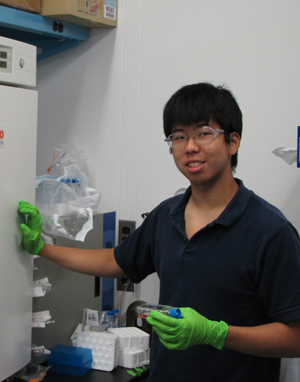David JiaUniversity: Carnegie Mellon University Project: Immobilization of Tissue Cells Using Positive Dielectrophoresis and Polyelectryolyte Multilayers Cell manipulation techniques (e.g. dielectrophoresis, cell patterning using adhesive materials) have been important components of the lab-on-a-chip toolbox for the last few years. Precise positioning of cells in microfluidic systems using electronic means had relied, in many instances, on dielectrophoresis (DEP) trapping forces. Although the first uses of DEP in microfluidic applications were to sort cells for analyses post treatment, growing interest in trapping cells for further anchorage onto a surface for on-chip cell-based studies have flourished. Our group has previously shown the use DEP trapping forces along with polyelectrolyte multilayers (PEMs), specifically the positively charged polyallylamine hydrochloride (PAH) as the outermost layer, to trap and hold cells after dielectrophoretic forces are no longer applied. Here we present the use of polystyrene sulfonate (PSS), a negatively charged polyion, and fibronectin (Fib), an extracellular matrix protein, as adhesive materials to study the forces and effects of DEP/PSS and DEP/Fib on mouse NIH-3T3 cells. Indium tin oxide (ITO) electrodes were fabricated using standard photolithographic methods. The electrodes were connected to a waveform generator to apply the sine wave and voltage to generate trapping forces. Microfluidic devices were built by irreversibly bonding polydimethylsiloxane (PDMS) channels onto the ITO/glass substrates. We found that NIH-3T3 cells were trapped at 870 kHz when suspended in a 0.32 M sucrose solution (positive DEP). Cells were trapped and finally anchored onto Fib and PSS after the trapping forces were no longer applied. Current efforts are directed towards the measurement of the forces holding the cells to the adhesive material and decreasing the time the cells spend suspended in sucrose. This work has applications in cell migration, cell differentiation and cell-cell communication studies. |

